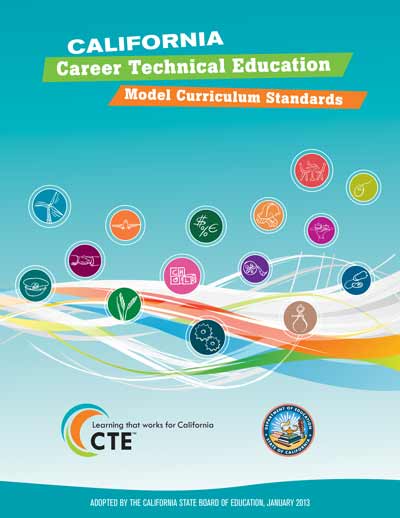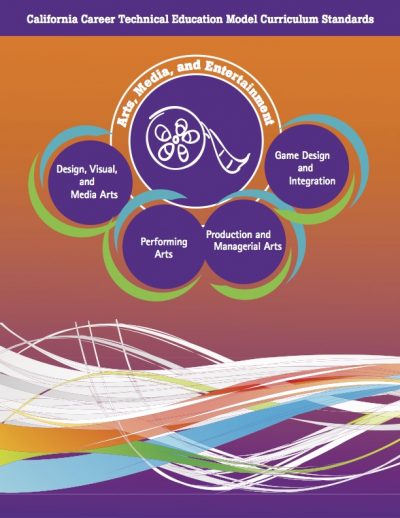
-
Design, Visual, & Media Arts
-
Performing Arts
-
Production & Managerial Arts
-
Game Design & Integration
California Standards for Career Ready Practice
- Apply appropriate technical skills and academic knowledge.
- Communicate clearly, effectively, and with reason.
- Develop an education and career plan aligned with personal goals.
- Apply technology to enhance productivity.
- Utilize critical thinking to make sense of problems and persevere in solving them.
- Practice personal health and understand financial literacy.
- Act as a responsible citizen in the workplace and the community.
- Model integrity, ethical leadership, and effective management.
- Work productively in teams while integrating cultural and global competence.
- Demonstrate creativity and innovation.
- Employ valid and reliable research strategies.
- Understand the environmental, social, and economic impacts of decisions.
Production & Managerial Arts Pathway
Careers in Production & Managerial Arts within the Arts, Media, and Entertainment sector require some form of a public presentation in one way or another, whether on the page or on the screen. The Production and Managerial Arts pathway focuses on technical skills as well as organizational and managerial knowledge required to bring arts, media, and entertainment to the public.
Sample Occupations:
Producers & Directors
Multimedia Artists & Animators
Camera Operators & Editors
Writers
Broadcast & Sound Engineering Technicians
Reporters, Correspondants & Broadcast News Analysts
PATHWAY COURSES
Digital Imaging
Course Description: The course focuses on creation and production of high-quality computer generated imagery. Students receive training in state-of-the-art industry software utilized in the creation of contemporary digitalized media. Hands-on interactive lessons provide a broad foundation and working knowledge of illustration, photographic, and layout software. Students are provided the opportunity to express their individual creativity while implementing principles associated with respected graphic design and visual communication techniques. Course content emphasizes the use of computer and electronic technology as a tool for creating commercial digitized media. Emphasis is placed on empowering students with knowledge of the employment potential in the various pathways of digitized media.
Television/Video Production Level I
Course Description: This course is designed to provide students with the opportunity to learn and explore the television and film/video industry, their history, and the careers involved. Students are exposed to and perform all facets of the job market in the areas of talent and production. Students will get a combination of classroom as well as hands-on training. The students will be responsible for all facets of production during the semester; ultimately leading to the production of a short student film. This is a beginning level course, which can be followedup with the Television/Video Production-Level II (Digital Film Production Level II) course. A certificate of training will be issued to students completing the course. Students may receive an official list of competencies achieved at the end of the course.
Television/Video Production Level 2
Course Description: This course is designed to provide students with the opportunity to apply the skills they learned in Television/Video Production – Level I to all areas of the television, film and video industries, and careers involved. Students perform all facets of the job market in the areas of talent and production focusing on producing a weekly talk show. Students will get a combination of classroom as well as studio (where available) ENG/EFP location training. This is an advanced level course and students are required to complete Television/Video Production – Level I or audition/interview before taking this course. This course may be repeated. A certificate of training will be issued to students completing the course. Students may receive an official list of competencies achieved at the end of the course.
ECONOMIC WORKFORCE DATA
In other words, how’s the job market?
Producers & Directors
create motion pictures, television shows, live theater, commercials, and other performing arts productions- The Median Annual Wage in 2018 was $71,680
- The Bottom 10% earned less than $34,450
- The Top 10% earned more than $163,540
- Typical Entry-Level Education: Bachelor’s degree
- Number of Jobs (2018): 152,400
- Employment Forecast: +5% over 10 yrs (2018 – 2028)
- More Info: Bureau of Labor Statistics
Multimedia Artists and Animators
create images that appear to move and visual effects for various forms of media and entertainment- The Median Annual Wage in 2018 was $72,520
- The Bottom 10% earned less than $40,870
- The Top 10% earned more than $124,310
- Typical Entry-Level Education: Bachelor’s degree
- Number of Jobs (2018): 71,600
- Employment Forecast: +4% over 10 yrs (2018 – 2028)
- More Info: Bureau of Labor Statistics
Camera Operators & Editors
manipulate moving images to entertain or inform an audience- The Median Annual Wage in 2018 was $58,990
- The Bottom 10% earned less than $25,790
- The Top 10% earned more than $102,470
- Typical Entry-Level Education: Bachelor’s degree
- Number of Jobs (2018): 69,200
- Employment Forecast: +11% over 10 yrs (2018 – 2028)
- More Info: Bureau of Labor Statistics
Writers
develop written content for various types of media- The Median Annual Wage in 2018 was $62,170
- The Bottom 10% earned less than $31,700
- The Top 10% earned more than $121,670
- Typical Entry-Level Education: Bachelor’s degree
- Number of Jobs (2018): 123,200
- Employment Forecast: +0% over 10 yrs (2018 – 2028)
- More Info: Bureau of Labor Statistics
Broadcast and Sound Engineering Technicians
set up, operate, and maintain media equipment- The Median Annual Wage in 2018 was $43,660
- The Bottom 10% earned less than $23,900
- The Top 10% earned more than $84,250
- Typical Entry-Level Education: Associate’s Degree/Certified
- Number of Jobs (2018): 144,300
- Employment Forecast: +8% over 10 yrs (2018 – 2028)
- More Info: Bureau of Labor Statistics
Reporters, Correspondents, and Broadcast News Analysts
inform the public about news and events- The Median Annual Wage in 2018 was $43,490
- The Bottom 10% earned less than $27,370
- The Top 10% earned more than $200,180
- Typical Entry-Level Education: Bachelor’s degree
- Number of Jobs (2018): 49,700
- Employment Forecast: -10% over 10 yrs (2018 – 2028)
- More Info: Bureau of Labor Statistics


